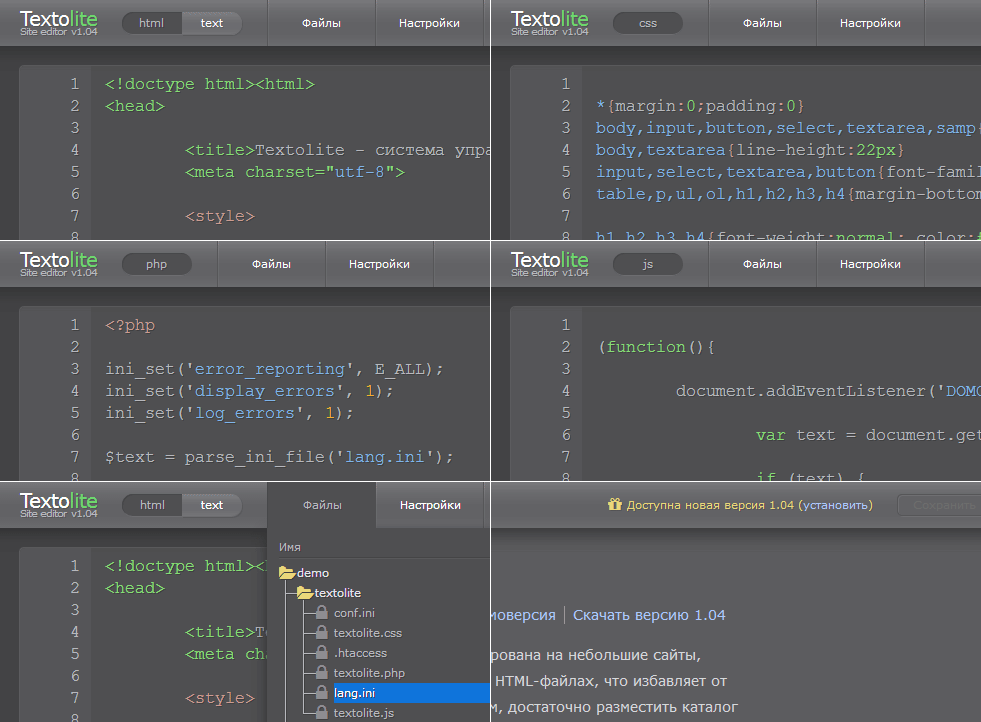Textolite 1.04: you can create templates and edit scripts
Not so long ago the release of the Textolite system on Habré took place . Since then, three versions have already been released, all of which were mainly associated with fixing bugs and finalizing existing capabilities. And now the first version is ready, expanding the capabilities of the system. For this version, the hottest topics were selected: the lack of the ability to create templates and edit anything other than HTML files. About what eventually changed further.

Added the ability to edit files with the extension php, js, css, shtml, shtm, stm. The system was tightly tied to HTML files, the addition of such features led to a major change in the HTML editor. The new version has significantly improved syntax highlighting mechanism. More elements stand out. Separate color schemes have been created for all file types. Slightly improved performance. Added the ability to save changes by pressing Ctrl + S. In general, adding support for script files changes the purpose of the system. If initially the system was guided by small static sites, now, with the ability to split pages into templates, sites can be of any size and not necessarily static.
Added the ability to update the system with one click through the web interface. In the previous version, the release of the new version was accompanied by a notification in the panel in the form of a download link. To update, the user had to download the archive, unzip, upload new files to the server. This approach may be inconvenient. If the system will be updated more often than the site, any desire to keep the system up to date will disappear. If someone else installed the system on the user, such a notification can be completely useless. In the new version, a notification is displayed along with a link to start the installation. Installation takes a couple of seconds and does not require any additional actions. The system itself downloads new files and updates with the preservation of all existing settings.
The lang.ini configuration file has been created to create translations of the system interface into other languages. The audience of system users has already managed to go beyond the Russian-speaking part of the network, which raises the issue of interface localization. There was multilingualism in the system initially, but there were only two languages: Russian, English. In the new version, users can create their own translations into any languages or improve existing options without outside help.
A complete list of all changes for all versions can be found on the project website .

Added the ability to edit files with the extension php, js, css, shtml, shtm, stm. The system was tightly tied to HTML files, the addition of such features led to a major change in the HTML editor. The new version has significantly improved syntax highlighting mechanism. More elements stand out. Separate color schemes have been created for all file types. Slightly improved performance. Added the ability to save changes by pressing Ctrl + S. In general, adding support for script files changes the purpose of the system. If initially the system was guided by small static sites, now, with the ability to split pages into templates, sites can be of any size and not necessarily static.
Added the ability to update the system with one click through the web interface. In the previous version, the release of the new version was accompanied by a notification in the panel in the form of a download link. To update, the user had to download the archive, unzip, upload new files to the server. This approach may be inconvenient. If the system will be updated more often than the site, any desire to keep the system up to date will disappear. If someone else installed the system on the user, such a notification can be completely useless. In the new version, a notification is displayed along with a link to start the installation. Installation takes a couple of seconds and does not require any additional actions. The system itself downloads new files and updates with the preservation of all existing settings.
The lang.ini configuration file has been created to create translations of the system interface into other languages. The audience of system users has already managed to go beyond the Russian-speaking part of the network, which raises the issue of interface localization. There was multilingualism in the system initially, but there were only two languages: Russian, English. In the new version, users can create their own translations into any languages or improve existing options without outside help.
A complete list of all changes for all versions can be found on the project website .
